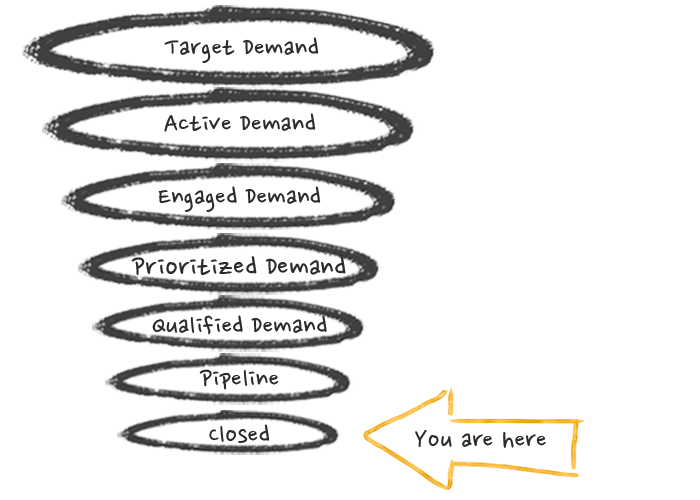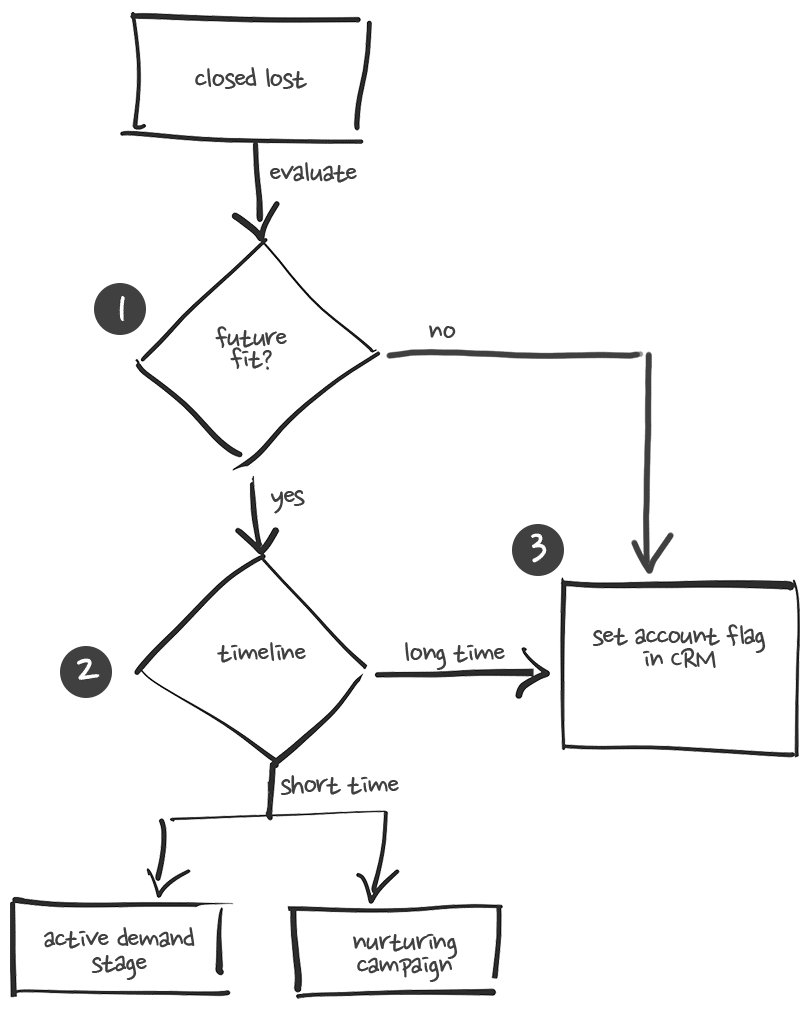
Your job is not done when the account closes. This is true whether the account is closed-won or closed-lost.
The principal objective in this Closed stage is understanding what is working and what is not throughout the Demand Unit Waterfall, and what that learning implies for the fine-tuning of your processes, messaging and collateral.
The stumbling blocks
Getting input from the sales team when they have moved to other accounts in their pipeline. Salespeople are incentivized to sell, and so it can be hard to pull them away from working accounts in their pipeline to provide input about closed accounts.
One critical thing that must happen at this stage is making sure that the sales team is indeed closing the account, one way or another. There is a tendency to hoard accounts that have not closed-won in the hope that something will change and the account will re-engage. What should happen is that the accounts that “go dark” get closed and either recycled back to the top of the Waterfall or into nurturing campaigns where you can work to keep the account warm. Once activity with the account heats up again, it is progressed back down the Waterfall.
Figuring out account disposition. In most companies, accounts that are closed-won are handed over to an onboarding or customer success team, and the marketing organization typically does not have a role there. In cases where there is additional opportunity to cross-sell or up-sell (“white space opportunities”) the new customer, you want the sales team to flag that for you so you can either nurture the new customer with other products or services and add them to those campaigns, or look to cross-sell to other groups in the account. In either case, you will either put those Demand Units into your Active Demand stage of the Demand Unit Waterfall or if you have indications that they are already in-market, put them in the Engaged Demand stage.
If getting in-depth feedback from the sales team on closed-won accounts is a challenge, getting that feedback from closed-lost is doubly so, even though understanding why an account does not buy is just as informative as for why they do buy. The same rules about feedback need to be applied to all closed accounts, won or lost.
In some (many?) cases an account will go dark and has to be closed because of it. In those cases, the salesperson will not have a specific reason that the account did not buy, but a close investigation of the interactions, both responded to and not responded to is necessary. What you are looking for is patterns common across closed-lost accounts.
Inspect these items:
- Are accounts not responding at all? If so, maybe you need to tighten up the validation process in the Qualified Demand stage to reduce the number of accounts that enter the Pipeline stage.
- Is there a specific area in the sales pipeline that the accounts go dark in? If so, check whether the sales team is moving them through the sales pipeline without enough interaction, or whether the sales collateral you have produced isn’t achieving its purpose.
Preparing for success
Have a defined process for gaining intelligence about closed accounts. This is some of the most valuable feedback that you will get, and that value will accrue to both the sales and marketing teams. There are several ways you could approach this. My preference is to get the sales managers to agree that there will be a standard set of questions applied to every closed account that the salesperson needs to complete.
Prepare a set of questions that should be answered to close an account built directly into your CRM. Make some of those questions mandatory and some optional so that the salesperson gives you the baseline information that you need while also having the opportunity to provide extra color. The reason that I prefer this approach is that if you talk to a salesperson about an account, you will usually get a lot of qualitative data, so it is there. However, asking a busy salesperson to write out what they learned from the account is a lot to ask. By providing them with a set of questions, they are not staring at a blank screen and can usually be a lot more articulate and time-efficient.
Inspect the interactions yourself. You should also spend time in your customer relationship management system reading through and listening to (when recorded) the interactions with closed accounts. You will learn a lot from doing this regularly.
Have regular cadence of win/loss meetings. Have these regularly, ideally at least monthly. Here again, provide lots of structure for the meeting, or you will find it is not well-attended over time and the input you are looking to get out of it will not be achieved.
Pick specific accounts to talk about. Have prepared questions given to each salesperson that you will present several days ahead of the meeting, so they are ready and have had time to go back and think about all their interactions with the account.
Have a plan for how closed-lost accounts are going to be recycled in your sales and marketing automation systems after the close. Below is an illustration of how you might evaluate and disposition closed-lost accounts:

- Evaluate whether the account will ever be a fit for your products or services.
- If yes, determine whether they might be a fit over the short or long term. I define a long time as greater than one year. If it’s a long time, set an account flag in your CRM so you can pull them back into the Waterfall in a year, two or whatever timeline the salesperson thinks. If it’s a short time, put the accounts into nurturing campaigns designed explicitly for closed-lost accounts or push the account back to the top of the funnel into the Active Demand stage.
- For accounts that were a hard “no,” you can disqualify them as potential customers in the future and have that state called out in your CRM. Or you might set up a program that puts the account back into the Active Demand stage after a specific amount of time. Remember that companies evolve their business, their staff changes, and their needs change. Can they be a good prospect a year in the future? Three years in the future? If it is a viable account, you don’t want to set them to the “disqualified” state where no one will ever call on them again.
Review your buyer’s journey. Are you learning something about the buying process that you had not considered and therefore is not captured in the buyer’s journey?
Analyze what sales and marketing collateral has been consumed. Evaluate closed-won and closed-lost separately. The closed-won analysis should provide a view on what content is being consumed and what is not, giving you a view on what customers value in their buying process. Your closed-lost analysis should be a more in-depth inspection of where accounts are going dark in the sales pipeline stages. You will want to come up with hypotheses on why accounts are going dark in those stages and then test new collateral to see if you can improve the gone-dark percentage in that stage.
You should also consider what collateral is not getting consumed and remove it from the customer journey and availability to the sales team. This may be a bit controversial, as you went through the effort to produce it, and it is easy to reason that maybe there will be some deal in the pipeline where it will be helpful, but by keeping content that does not perform well in the pipeline you are introducing more complexity, more sales training and reducing sales’ confidence in marketing. Put these in your back pocket and make them available only upon request.
Automation. The logic around the dispositioning of closed accounts can be automated in your marketing and sales automation systems. Whether or not to do that depends on the volume of closes you have. It is probably not worth automating if you sell low-volume, high-priced products. However, if you have high-volume sales, it is going to be worth automating.
Team makeup
Sales and marketing need to work together in evaluating what accounts are telling us. This may be an unfair observation from a marketer about sales, but it seems to me that a lot of the closed-lost feedback from the sales team has to do with some piece of collateral or information that they could not produce for the customer. I think it’s important for marketing to be respectful of sales’ feedback but also to make sure to probe a little deeper. This is especially true because accounts will often make requests to slow the deal down or throw up a hurdle because they are reluctant to tell the salesperson that they are not going to buy.
Separating true needs from objections framed in the form of a need is critical if you don’t want to be chasing your tail.
You will also be working with your marketing and sales operations teams on the strategy and execution of dispositioning closed accounts.
Deliverables
- Sales/marketing “post-mortem” meeting cadence
- Analysis of which collateral was consumed by closed-won accounts
- Account recycling plan for closed-lost accounts
Measuring success
The principal KPI here is deal velocity measured as days-to-close. This Closed stage is all about evaluating how the entire Demand Unit Waterfall and the materials and interactions that had been programmed into it have performed.
If done well, B2B marketing using the Demand Unit Waterfall should improve your close rates and deal velocity. If you’re being proactive about getting the right materials in front of the accounts at the right time and in the way that they need, it’s going to be a lot easier for these accounts to move the purchase process forward inside their organization, thus improving deal velocity and deal size.



